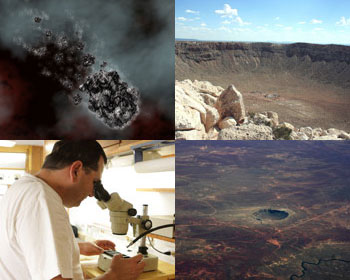A Publication of the
Applied Math and Science Education Repository

The AMSER Science Reader Monthly aims to provide educators with a useful package of information about a particular topic related to applied math and science by combining freely available articles from popular journals with curriculum, learning objects, and web sites from the AMSER portal. The AMSER Science Reader Monthly is free to use in the classroom and educators are encouraged to contact AMSER with suggestions for upcoming issues or comments and concerns at [email protected].
This month's AMSER Science Reader Monthly topic is Meteorites and Geology.
Meteorite Strikes Peru: Geologists rush to study the crater and pieces left behind
Article by Lionel E. Jackson Jr., Peter Brown, Jay Melosh and Dolores Hill from Geotimes
Synopsis and resource annotations by Max Grinnell

When something falls out of the sky, what happens? It is a question that has puzzled scientists for decades, and while many objects strike the earth's surface (thereby becoming a meteorite), three-quarters of them touch down in open water. In 2007, a meteorite landed in Carancas, Peru and the landing presented some rather unique opportunities for geologists.
In the July 2008 issue of Geotimes, scientists Lionel E. Jackson Jr., Peter Brown, Jay Melosh and Dolores Hill offered their own account of this meteorite strike in Peru, the crater it created, and the ensuing buzz of scientific activity. It all started on the morning of September 15, 2007 when a bright fireball moved across the sky over Lake Titicaca. Upon final impact a few seconds later, eyewitnesses noted that the meteorite had left a 13.5 meter wide crater, and that fragments of the meteorite landed as far away as 200 meters.
The meteorite presented a rather compelling and fairly unique situation for scientists all over the world. It was the chance to study fragments of a fresh impact crater and to take a close look at a chondrite. A chondrite is a stony meteorite that generally breaks up in the atmosphere; the largest intact chondrite to reach the Earth's surface was during the Jilin, China meteorite shower in 1976.
The scientists moved quickly and began working with Peru's geological survey team on examining the meteorite. One of the survey members, Luisa Macedo, was able to cut the impact samples into thin, polished sections which under a microscope revealed that the meteorite was in fact a chondrite. The Lunar and Planetary Laboratory at the University of Arizona later confirmed this finding, and scientists have also been able to determine the meteorite's velocity, mass, and impact angle.
One puzzle remained as scientists continued to research the meteorite and its impact site. Why did this object create a round crater? This was a particularly vexing question, as the meteorite had entered the atmosphere at an acute angle. In most cases an acute impact angle would create an elliptically-shaped crater, but that was not the case here. Scientists eventually drew on information from other fields to determine that at such high speeds the resulting crater is created by a massive explosion. With that in mind, such variables as angle of approach and size cease to be of much importance in determining the final crater form.
Found below is a list of useful resources that will illuminate and enhance understanding of the topics found within this article. The first three links are broadly related to the world of meteorites, and the second group is related to geology. The first link will take interested parties to Washington University's Lunar Meteorites website, which contains some basics on the world of meteorites, including answers to questions such as "How are lunar meteorites classified?" The second link leads to a NASA news commentary from David Morrison on evidence that suggests that a massive impact triggered the Permian-Triassic extinction. Moving on, the third link leads to the homepage of the Association of Lunar and Planetary Observers. This site also has some good information on meteorites, along with sections dedicated to Jupiter, Saturn, and a sample of minor planets. The fourth link leads to the OpenCourseWare page for an introductory geology course at MIT taught by Professor Lindy Elkins-Tanton. The site includes lecture notes, a syllabus, assignments, and other course materials. The fifth link leads to an interactive resource on the Earth's interior, created by the people at the Annenberg Media project. The last link leads to an excellent series of teaching activities related to structural geology created by a team at the earth sciences department at the University of Leeds. Overall, these resources should provide greater scope and help contextualize the ideas and concepts found within in the featured work. The list provides links to resource records in the Applied Math and Science Education Repository (http://amser.org/).

